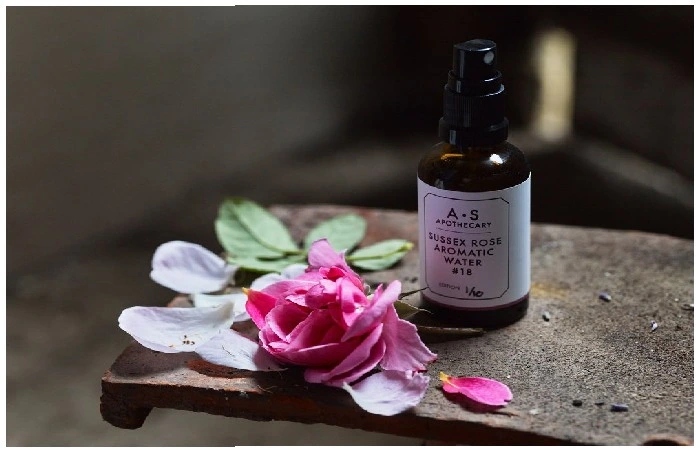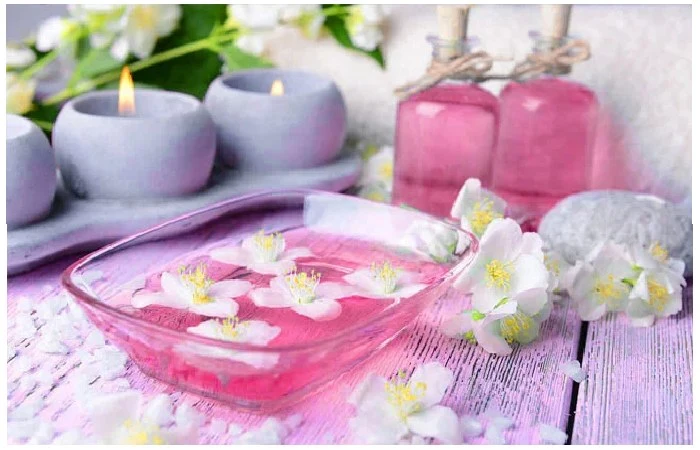According to the USP, “Aromatic Waters or Medicated Waters is a clear saturated aqueous solution of volatile lubricants or other aromatic or volatile substances” unless otherwise specified. They should not have any empyreumatic (smoke-like) or other foreign odours, and their flavours and aromas should be identical to those of the drugs or volatile materials from which they are prepared. They are typically used as carriers for flavours and fragrances. When making unofficial preparations, volatile ingredients used to make aromatic waters should be of a pharmaceutical quality or the best, if desired, flavour.
Table of Contents
What is Aromatic Water?

They are occasionally known as Floral Waters or Hydrolats. Aromatic waters are trendy in the skin care industry and work wonders for itchy skin. They are a component of the distillation process used to produce essential oils and contain all active principles and water-soluble molecules. Various herbs serve various purposes, such as Rose for comfort and pleasure, Juniper for astringency, and Chamomile for calming. They are used occasionally in cooking to add flavour or aroma.100% natural and pure, simple and secure to use.
How aromatic water is formed?
Are volatile oil, essential oil, or solid material liquid pharmaceutical preparations.
Because there is only a small amount of volatile substance, aromatic water has little therapeutic benefit.
They are utilised in pharmacies as a palatable and flavouring medium or a delivery system for administering water-soluble drugs to cover up their unfavourable tastes and odours.
Distillation method
This method creates rose water, camphor water, hamamelis water, peppermint water, and order, all made from fresh plant materials.
Solution method
The essential oil containing the aromatic material in a closed container is agitated with purified water (2ml or 2gm aromatic materials mixed with 1000ml of water) for 15 minutes. The mixture is set aside for at least 12 hours to settle the excess oil and solid substance. Then pass enough purified water through the filter paper to make the product measure 1000 ml.
What is the five examples of aromatic water?
Aromatic waters are clear aqueous solutions soaked with volatile oils (such as rose oil or peppermint oil) or aromatic or flammable substances such as camphor. Their odours and tastes are similar to the drugs or volatile materials from which they are derived.
1) Water vapour distillation is used as a distillation method. The distillate produced by this method is known as hydrolase. The hydrolate is then filtered through filter paper after it has been obtained.
2) Simple dissolution of essential oils in water: Prepared by directly combining critical oil and solvent.
3) Using an excipient or dispersing agent to dissolve essential oils:
How do you use aromatic water?

Aromatic waters, also known as hydrosols or hydrolats in aromatherapy practice, have several health benefits. While most people associate aromatherapy with essential oils, interest in aromatic waters is growing. Aromatic waters once thought to be a byproduct of essential oil distillation, are now valuable commodities in their own right.
Aromatic Waters in France
Although many people are only now becoming aware of the healing power of aromatic waters, the French have been using them for years. France recognises the powerful therapeutic effects of essential oils as a nation, and French literature also records the use of aromatic waters (source: Aromatherapy for Health Professionals, Shirley Price, Len Price).
Uses of Aromatic Water
Aromatic waters have numerous therapeutic properties but are mainly used for skin care and cosmetics. Aromatic water can also be used internally to treat various disorders; however, you must be trained in aromatic medicine (as opposed to general aromatherapy practise) to do so. It is also critical that you know the quality and source of the aromatic waters and assurance that the aromatic waters are not synthetically produced.
Some of the health benefits of aromatic waters include:
- skincare
- eyewashes
- pain control
- burns
- gargles
- hair rinses
- digestive complaints
Aromatic Water In Pharmacy
Aromatic waters are pharmaceutical aids primarily used for fragrance and flavouring formulations. They can be used in formulating other pharmaceutical preparations as excipients, bases, or vehicles. Aromatic waters can be used for a variety of purposes.
- camphor water has been used as a vehicle in ophthalmic solutions due to its ability to add a refreshing and stimulating effect to the preparation.
- Rose water has antioxidant properties. Rose water cleanses, tones, and protects the skin from the effects of the environment. The dose of simple aromatic water is typically 15 to 30 mL, but this varies depending on the water. Storage Requirements Aromatic waters deteriorate over time, so they should be made in small quantities and kept away from direct sunlight and extreme heat.
Conclusion
Our website has covered some important points about Basket Bag in the preceding article. We hope you found the above information informative and helpful. Please return to our website to read more exciting articles.
